Demography may be playing a substantial role in fueling the current uprisings in Iran. The most recent population census taken last fall shows the age structure of the population and the sizes of the different cohorts. The single-age pyramid for 2016 below shows clearly the unusually large cohorts of the baby boomers (born in the early years of revolution who are now in their late 20s and early 30s) who have moved up into the voting age range since 2006.
Figure: The age structure of Iran’s population 2006-2016
Source: Statistical Center of Iran, national censuses of population.
Because of their size, these cohorts have a noticeable effect on Iran’s social and political landscape. As this “youth bulge” moves up the age ladder, it pushes the median age up and in some sense matures the population more rapidly than one would expect. For example, since 2006, about when Ahmadinejad was first elected, the median age has increased from 24 to 31 today. By way of comparison, the median age in Afghanistan is 19 and in the US, where the median age is 38, it has increased by less than one year in ten years.
The median voter age has also increased, from 33 to 37 (again, by comparison, this is 45 in the US). Whereas in 2006 youth voters under 34 were the majority voters, today they are not.
In terms of the number of votes, youth are declining in significance. The youngest cohorts of voters (aged 18-24) were 24% of all voters in 1996, when President Mohammad Khatami was first elected, but fell to 20% in 2006 and to 14% in 2016. The share of the 18-29 age group, which had been stable at around 40% in 1996 and 2006, has fallen to 29% in 2016.
These age groups happen to be those with the greatest rates of unemployment, which has gotten worse over time. According to survey data, in 2015/16, a shocking 31% of men and 53% of women aged 18-29 were unemployed, compared to 20% and 19% in 1997. More importantly, the pain of this worsening situation is increasingly felt by older age groups. Entire families are affected when their young men and women are unable to find employment, housing, and form a family. In 2015/16, 82% of men and 55% of women in this age group lived with their parents. Difficulty in finding a job and housing means staying single as well: In 2015/16, 76% of men and 49% of women 18-29 had never married.
So, the economy — especially jobs, housing, and marriage– is on the minds of Iranians of all ages, more so than in the past. The fact that the political class is not offering clear initiatives to deal with these problems must be frustrating for citizens who are taking their anger to the streets.
Originally published on www.djavadsalehi.com.




